Blades made from the ninth year of Meiji (1868-1912) until present day are referred to as gendaito (modern swords). As of the Hatorei decree in 1876 (banning civilians from wearing swords), the need for swords declined. However, in Meiji 39 (1906), the craft gained imperial patronage. The sword smiths Gassan Sadakazu and Miyamoto Kanenori were appointed Tei Shitsu Gi Gei In (craftsmen by imperial appointment—equivalent to National Living Treasure). Since then, the sword smith’s craft has continued through the Meiji, Taisho (1912-1926), Showa (1926-1989), and Heisei (1989-) eras until today. Today’s sword smiths try to recreate the workmanship of eminent smiths of every period, regardless of whether they are koto, shinto, or shin-shinto. In particular, recreations of tachi of the Kamakura period are a popular aim for many modern sword smiths.
To read more, download volume 20, issue 3 of the “SMAA Journal” in our library.
Choose an Authentic Martial Arts Association
SMAA offers five divisions of authentic Japanese martial arts: aikido, iaido, judo, jujutsu, and karate-do. If you’re looking for a new martial arts association to kickstart the new year, give us a call at (734) 720-0330 or submit a contact form here. We look forward to helping you develop your art!












